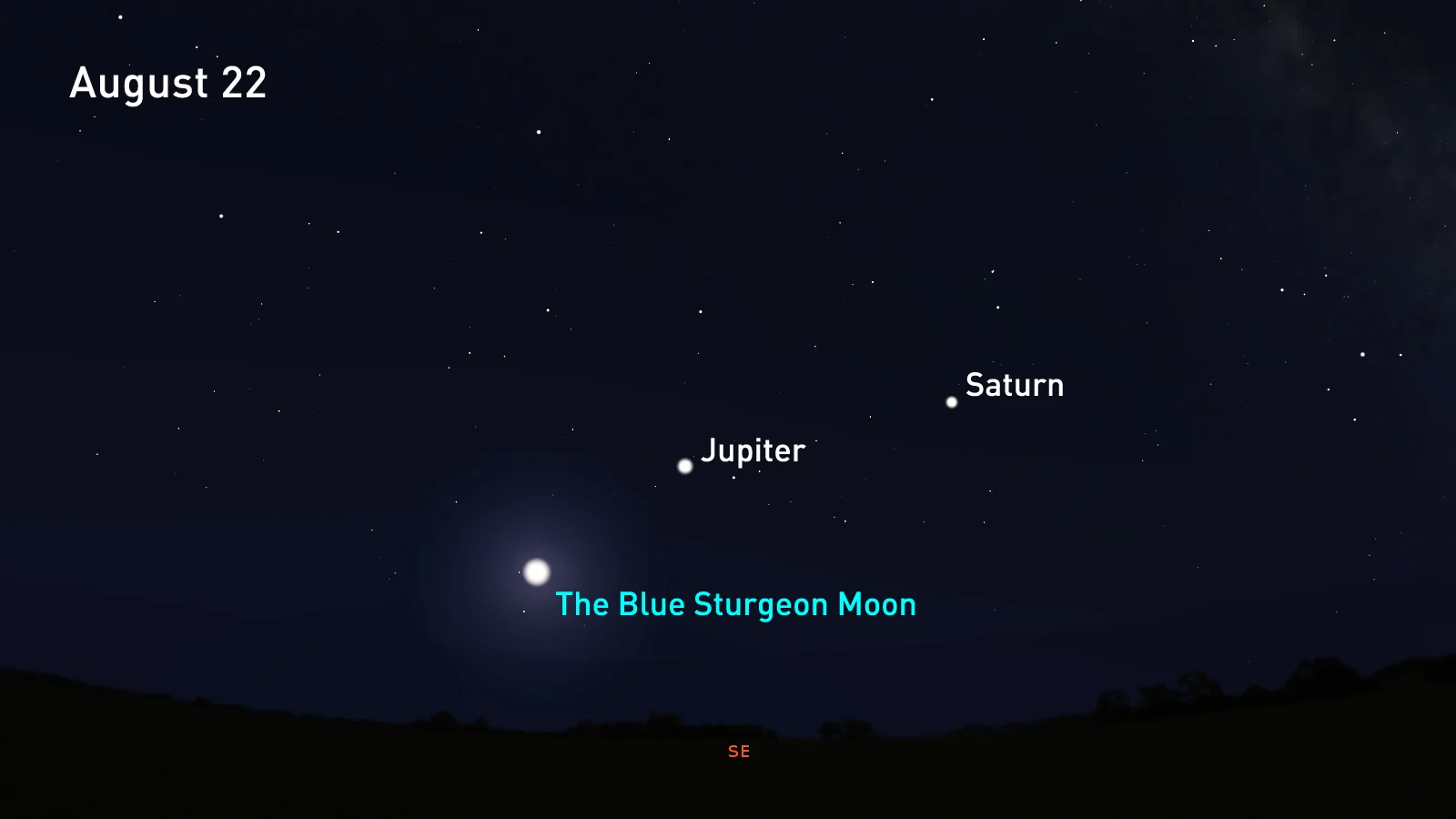
Here are the top sights to see in the night sky this summer
Thanks to some great timing with the phases of the Moon, the famous Perseid meteor shower promises to be especially good this summer.
Warm summer nights are just about the best time of year to stay up late and gaze at the night sky. Here is our guide to the astronomical sights on display for Summer 2021.
Jun 21: Summer solstice (northern hemisphere)
Jun 24: Full Strawberry Moon
Jun 26-29: Moon passes by Saturn and Jupiter
Jul 5: Earth at aphelion (farthest point from the Sun)
Jul 11-13: Venus near Moon and Mars
Jul 24: Full Buck Moon
Jul 24-26: Moon passes by Jupiter and Saturn
Jul 29: southern delta Aquariid meteor shower peaks
Aug 2: Saturn at Opposition
Aug 9-10: Moon close to Mars
Aug 12: Perseid meteor shower peak
Aug 20: Jupiter at Opposition
Aug 20-22: Moon passes by Jupiter and Saturn
Aug 22: Blue Sturgeon Moon
Sep 10: Moon very close to Venus
Sep 5: Zodiacal Light in the east before dawn for 2 weeks
Sep 17-18: Moon passes by Jupiter and Saturn
Sep 20: Full Corn Moon (Harvest Moon)
Sep 22: Autumn Equinox (northern hemisphere)
THE MOON AND THE PLANETS
Each month this summer, the Moon will pass very close to the planets Jupiter and Saturn in the night sky.
With Jupiter and Saturn still reasonably close together in our skies following last year's Great Conjunction, they are constant companions this summer. Each month, during the normal progression of the Moon's phases, it will pass by the two giant planets.

The positions of the Moon, Jupiter and Saturn around 2 a.m. local time on June 27. Credit: Stellarium/Scott Sutherland
Watch for the first pass around the nights of June 26-29. It comes around for a second pass from July 24-26, then again around August 20-22, and then again around September 17-18.
Want to see the Moon teaming up with planets closer to home? Look to the west just after sunset on the nights of July 11 and 12 to see it very low in the sky next to Mars and Venus. On July 11, the two planets will appear so close together that they may be difficult for the human eye to pick out as two separate objects!
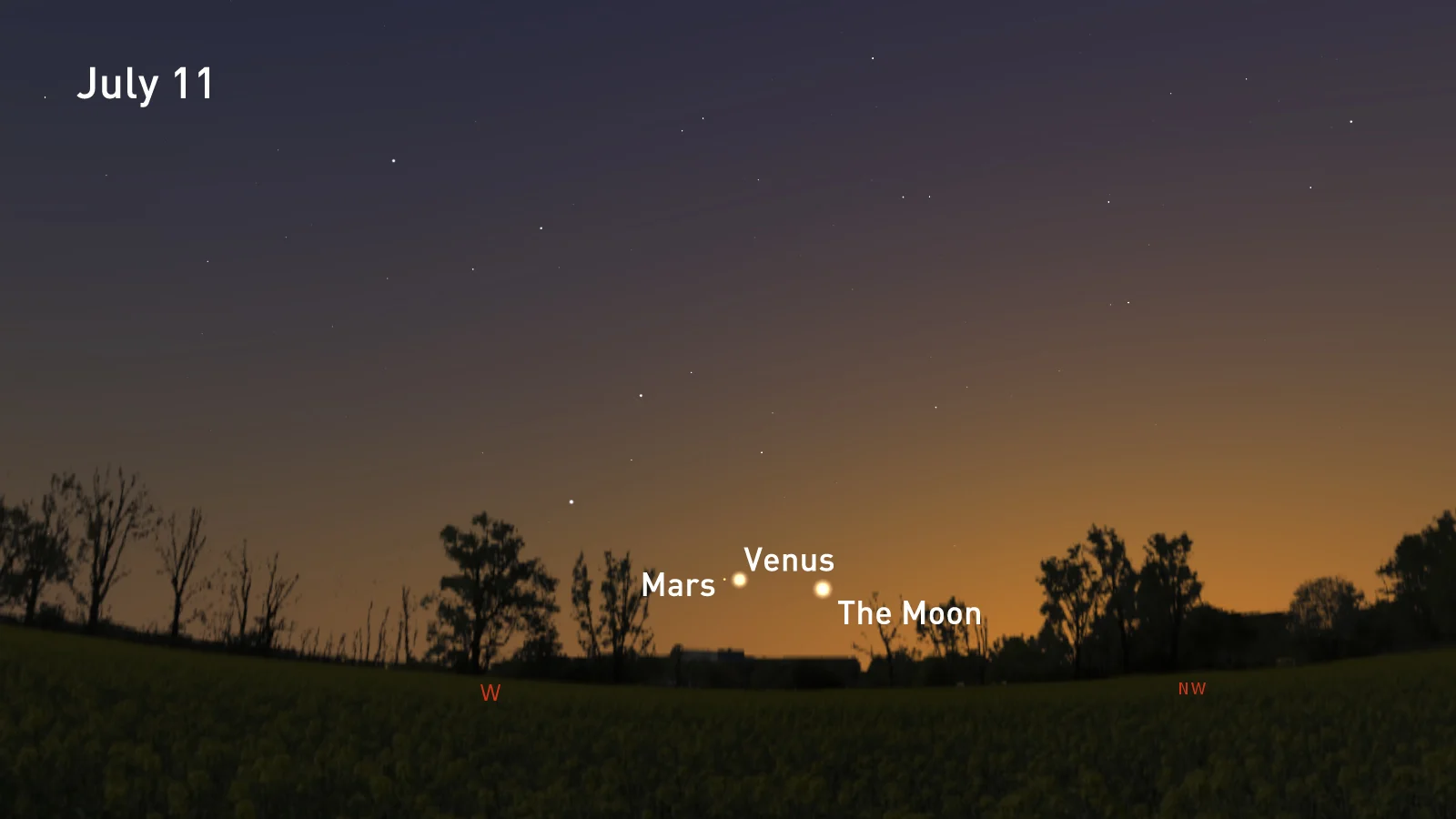
The Moon, Mars and Venus on the western horizon on the evening of July 11. Credit: Stellarium/Scott Sutherland
If you miss it or just want to see something like this again, the Moon will be with Venus in the same part of the sky, at roughly the same time, on August 7, and then with Mars around August 9. On September 9, the Moon pairs up with Venus at the same time and place, once more.
EARTH AT APHELION
On July 5, Earth will reach the farthest point from the Sun in its eliptical orbit for this year. This point is known as aphelion.
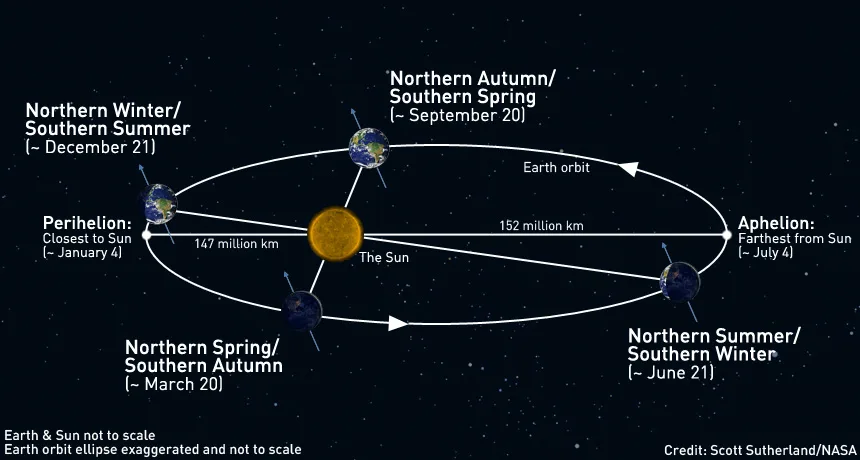
Earth's orbit around the Sun, noting the Solstices, Equinoxes and the timing of perihelion and aphelion. The image is not to scale. Credit: NASA/Scott Sutherland
We often talk about Earth 'circling' the Sun. However, our planet doesn't trace out a perfect circle as it travels in its yearly orbit around our home star. Instead, it follows an eliptical path, as shown in exaggerated detail in the diagram above.
Earth's average distance from the Sun (1 astronomical unit, or AU) is considered to be 150 million kilometres. Perihelion, Earth's closest point to the Sun during any year, usually takes place around January 4, plus or minutes a day or two. Aphelion, on the other hand, occurs around July 4 each year. While the planet's distance at perihelion averages out to around 147 million km, and average aphelion distance is around 152 million km, the exact distances vary from year to year.
From TimeandDate.com, Earth was 147,093,163 km away from the Sun during perihelion at 8:50 a.m. EST, on January 2, 2021. Aphelion occurs at 6:27 p.m. EDT on July 5, 2021, at a distance of 152,100,527 km.
Apparently, this is a noteable aphelion, too. According to retired NASA astrophysicist Fred Espenak this is the farthest aphelion we'll see until 2032.
You won't feel anything or see anything as this happens. It doesn't even have much of an effect on our seasons (which are caused by Earth's tilt). Still, perhaps pause for just a moment at the appropriate time, to mark the passing of this orbital milestone.
GIANT OPPOSITIONS
The two largest planets in the solar system, Jupiter and Saturn, will both reach Opposition within the month of August this year.
'Opposition' is an astronomical term for the exact moment when Earth is directly between the Sun and another planet, such as Mars, Jupiter or Saturn.
On August 2, Earth will be lined up perfectly between the Sun and Saturn. At this time, the planet will be up all night long, and it will be about the brightest we'll see it for the entire year.
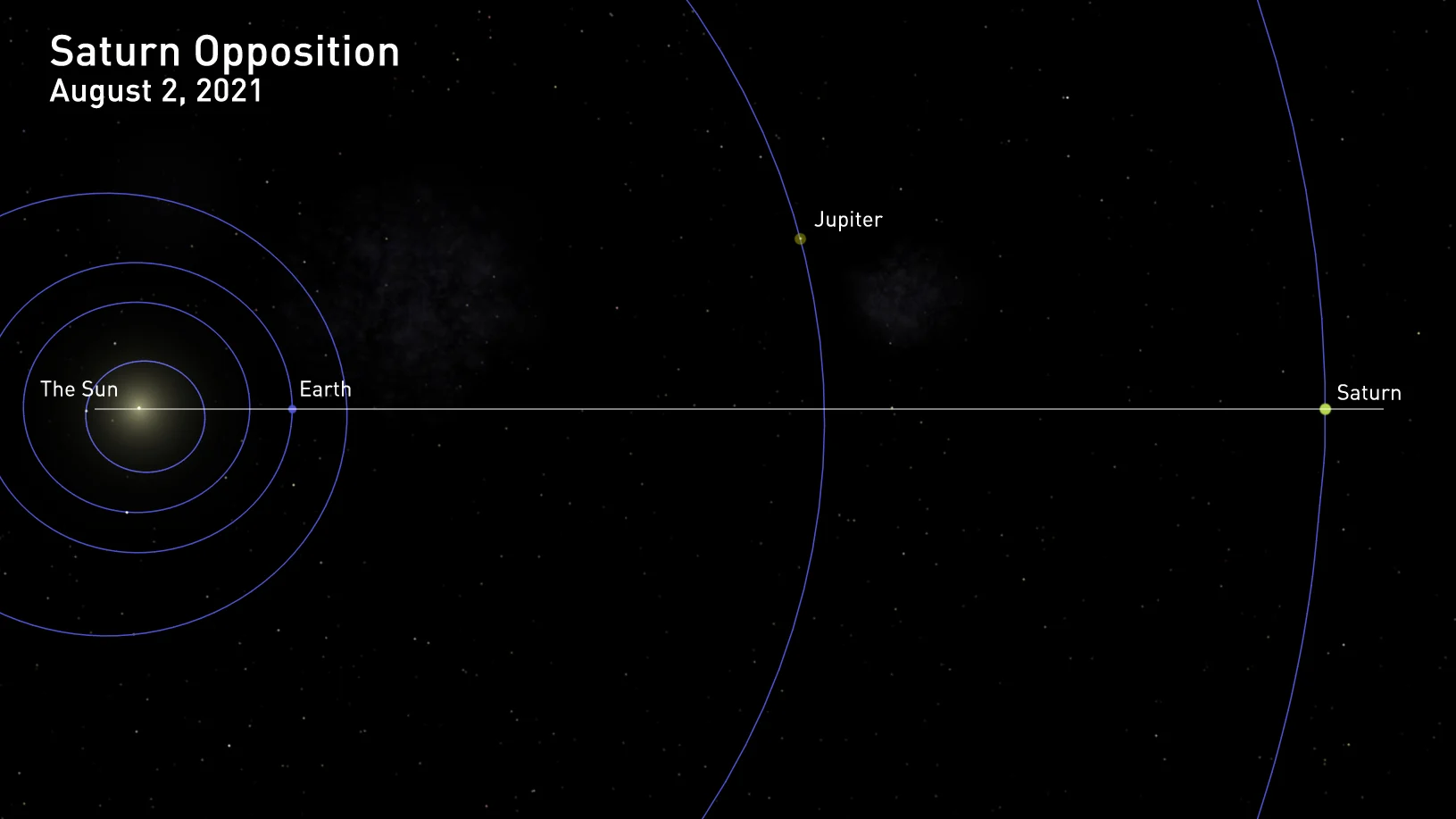
The Sun, Earth, and Saturn line up perfectly in Opposition on August 2, 2021. Credit: Celestia/Scott Sutherland
Later in the month, on August 20, Earth will catch up with Jupiter again. As with Saturn during its opposition, Jupiter will rise as the Sun sets and will be up in the sky until dawn, shining brighter than any other time of the year.

The Sun, Earth and Jupiter line up perfectly in Opposition on August 20, 2021. Credit: Celestia/Scott Sutherland
If you're wondering why the order of these oppositions is flipped from last year (in 2020, Jupiter Opposition was on July 14 and Saturn Opposition was on July 20), it's due to how quickly Earth and Jupiter move around the Sun compared to Saturn.
In the time it's taken Earth to travel around the Sun since last summer, Jupiter has moved a lot farther along in its orbit than Saturn has. So, as we "lap" the two planets this year, we line up with Saturn first and Jupiter second. This trend will continue for some time now, as the two giant planets get farther and farther away from each other.
METEOR SHOWERS
Every summer, Earth passes through two streams of icy, dusty debris, left behind by comets. When this happens, the bits of comet debris in the streams light up our night skies with a meteor shower.
First is the southern delta Aquariids, which originates (we think) from a comet named 96P/Machholz. It occurs between July 12 and August 24, and peaks on the night of July 29. This meteor shower is typically best viewed from the southern hemisphere, and the meteors tend to be rather faint. With the Full Moon just a few days before the 29th, the southern delta Aquariids is not an ideal event this year.
Between July 17 and August 24, though, we pass through another debris stream left behind by Comet 109P/Swift-Tuttle. This debris stream typically produces one of the best yearly displays in the northern hemisphere — the Perseid meteor shower.
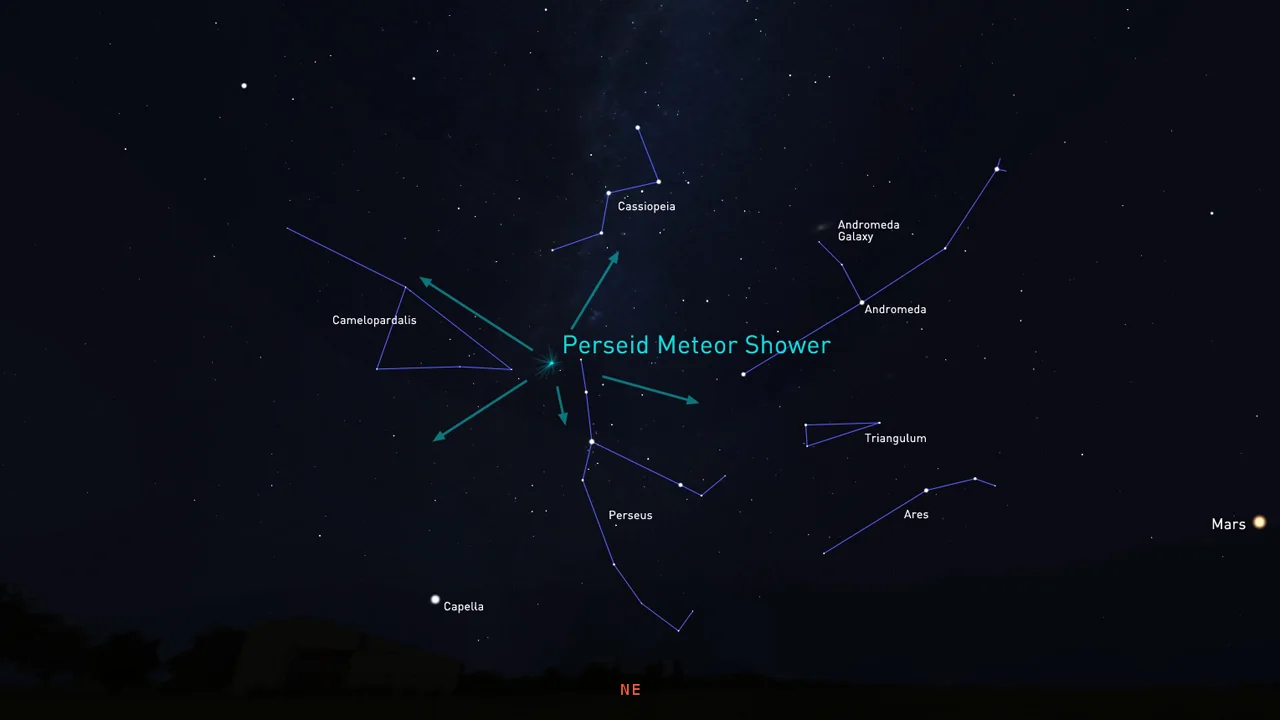
The location of the Perseids radiant at midnight on August 12-13. Credit: Stellarium/Scott Sutherland
By far the best summer meteor shower, the Perseids reach their annual peak on August 12. During this time, when Earth passes through the densest part of Comet Swift-Tuttle's debris stream, the shower can deliver up to 100 meteors per hour. Sometimes even more!
Simply based on varying brighness of the meteors and our limited field of view, the typical viewer tends to see about half that number (after they've gotten away from city light pollution). This rate slowly ramps down for about a week or so after the peak, allowing plenty of time to see more Perseid meteors before the shower ends.
NOTE: There's a handy guide at the bottom of this article for how to get the most out of watching a meteor shower!
The Perseids radiant — the position the meteors appear to originate from in the sky — is a special one. Positioned in the northern sky, it never sets below the horizon at this time of year. So, it's only a matter of waiting for the Sun to completely set to watch.
The best time to watch this meteor shower will probably be in the hours after sunset on August 12. The timing is nearly perfect, too, because it will be only a few nights after the New Moon. Thus, there will be very little competing light from the Moon in the sky, which will allow viewers to see more of the meteors from this shower.
The Perseids also has the distinction of being the annual meteor shower with the greatest number of fireballs — meteors that are so bright they can outshine the planet Venus!
Watch: Perseid fireball captured on camera
BLUE MOON
On the night of August 22, while the Full Moon is hanging out near Jupiter and Saturn in the sky, it will be a special one — a seasonal Blue Moon.
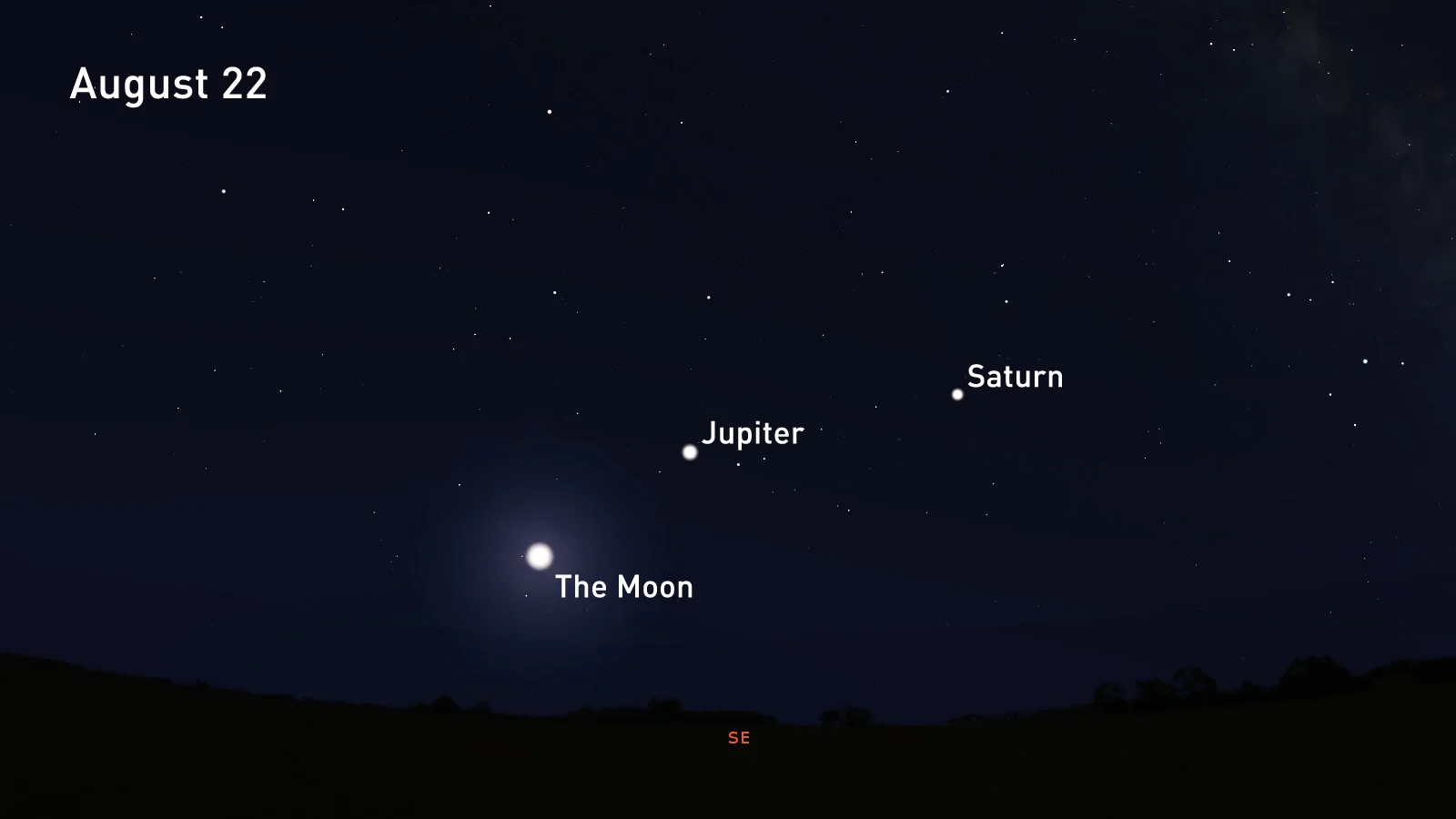
The Blue Moon hangs in the sky near Jupiter and Saturn on the night of August 22. Credit: Stellarium/Scott Sutherland
There are two types of 'blue moon' that we usually hear about. The kind that sticks in peoples' minds a bit easier, mainly because it's harder to miss, is when there are two Full Moons in a single calendar month. We saw this last in the Fall of 2020 when we had the October 31st 'Micro' Blue Moon.
The traditional definition of a Blue Moon, however, is "the third Full Moon in a season with four Full Moons."
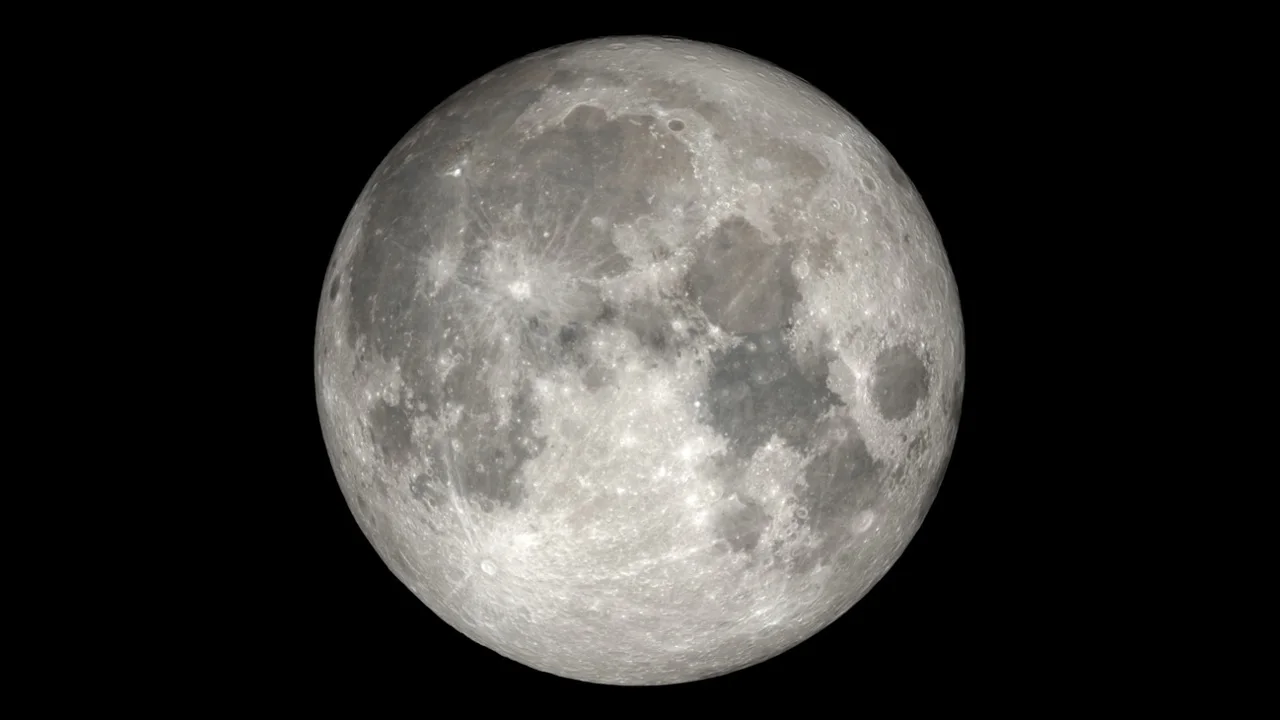
This visualization of the Moon, produced from images taken by NASA's Lunar Reconnaissance Orbiter, shows the August 22 Blue Moon. Credit: NASA's Scientific Visualization Studio
Usually, any particular season of the year will have 3 Full Moons. About every two or three years, though, we'll have a season where the first Full Moon occurs just after the season starts. That particular season will have FOUR Full Moons.
With Summer 2021 starting on June 20 and ending on September 22, and with Full Moons on June 24, July 24, August 22 and September 20, this is one of those Blue Moon seasons.
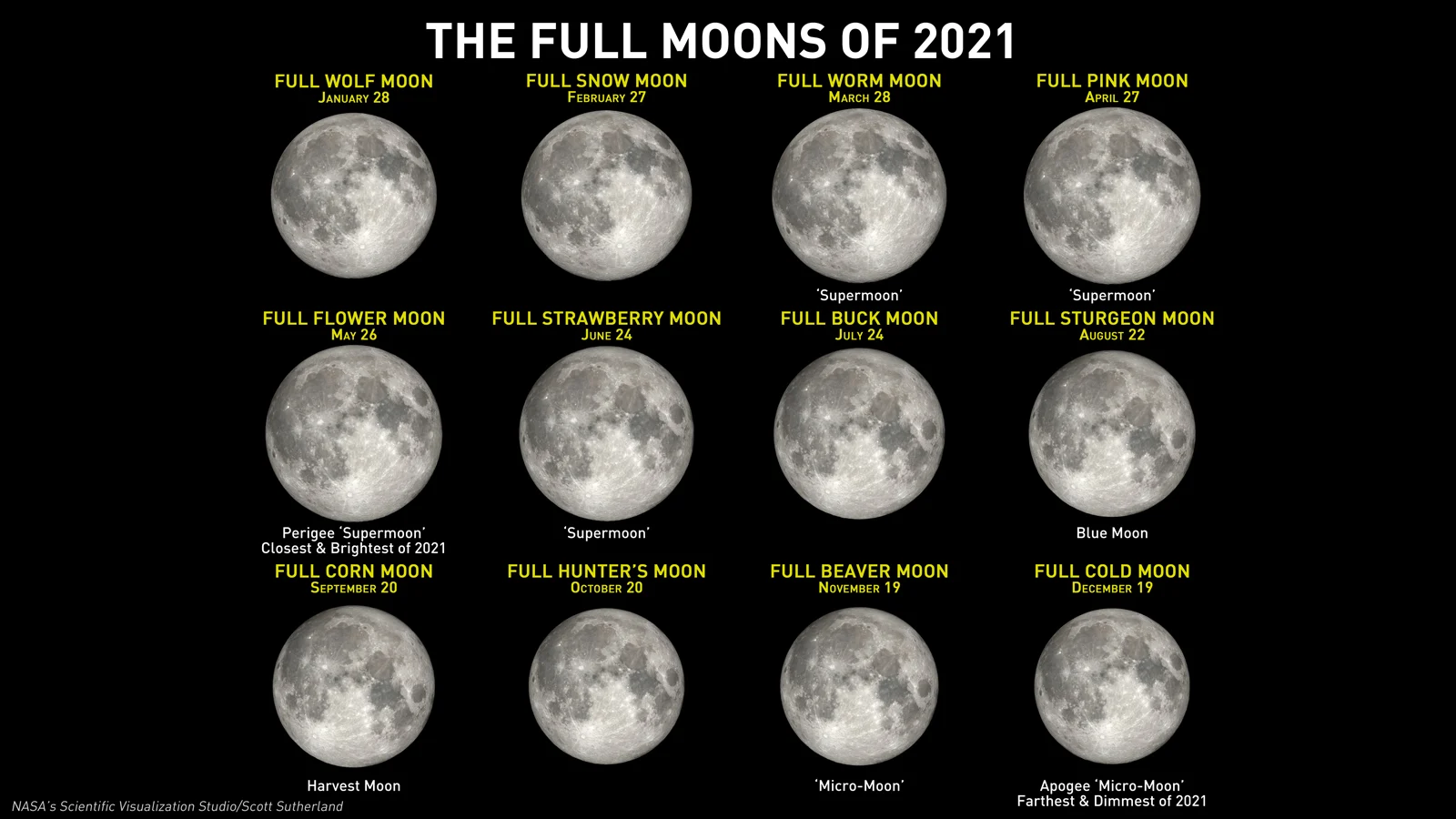
All 13 Full Moons of 2021 are presented here, along with their names and special characteristics. Credit: NASA's Scientific Visualization Studio/Scott Sutherland
We will see the next Blue Moons on August 30-31, 2023 (the second Full Moon that month) and on August 19, 2024 (the third Full Moon of that summer).
THE ZODIACAL LIGHT
In late summer, sharp-eyed skywatchers will have a chance to spot an elusive phenomenon known as the Zodiacal Light.
On clear nights and under dark skies, look to the eastern horizon, in the half an hour just before morning twilight begins, from around September 5-19. Specifically, look for a pyramid-shaped white glow, with the base along the horizon and the peak angled towards the south.
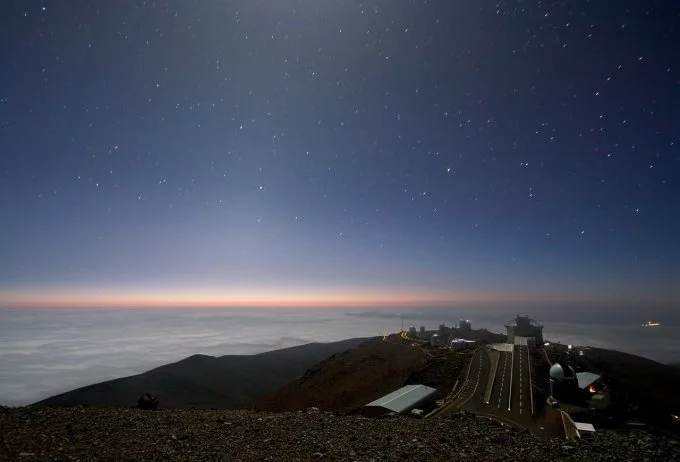
Moonlight and zodiacal light over La Silla. Credit: European Southern Observatory (ESO)
In the Royal Astronomical Society of Canada's 2021 Observer's Handbook, Dr. Roy Bishop, Emeritus Professor of Physics from Acadia University, wrote: "The zodiacal light appears as a huge, softly radiant pyramid of white light with its base near the horizon, and its axis centred on the zodiac (or better, the ecliptic). In its brightest parts, it exceeds the luminance of the central Milky Way."
The zodiacal light is caused by sunlight refracting off tiny bits of dust and ice that orbit around the Sun in the ecliptic plane (the same plane the planets orbit in). It was thought that this cloud originated from dust and ice blown off of comets. However, researchers using data from NASA's Juno spacecraft recently discovered that this light may actually be due to Martian dust floating in space!
According to Dr. Bishop, this phenomenon can be quite bright. However, the light is so diffuse that it can easily be spoiled by moonlight, haze or light pollution. Also, since it is best viewed just before morning twilight or just after evening twilight, inexperienced viewers sometimes confuse it for twilight and miss out.
TIPS FOR METEOR WATCHING
First, some honest truth: Many who want to watch a meteor shower end up missing out on the experience. Follow this guide to get the most out of these events.
Here are the three 'best practices' for watching meteor showers:
Check the weather,
Get away from light pollution, and
Be patient.
Clear skies are very important for meteor spotting. Even a few hours of cloudy skies can ruin an attempt to see a meteor shower. So, be sure to check The Weather Network on TV, on our website, or from our app, and look for my articles on our Space News page, just to be sure that you have the most up-to-date sky forecast.
Next, you need to get away from city light pollution. If you look up into the sky, are the only bright lights you see street lights or signs, the Moon, maybe a planet or two, and passing airliners? If so, your sky is just not dark enough for you to see any meteors. You might catch a bright fireball, but there's no guarantee, and those are typically few and far between. So, get out of the city, and the farther away you can get, the better!
Watch: What light pollution is doing to city views of the Milky Way
For most regions of Canada, getting out from under light pollution is simply a matter of driving outside of your city, town or village until a multitude of stars is visible above your head. In some areas, especially southwestern and central Ontario and along the St. Lawrence River, the concentration of light pollution is too high. Getting far enough outside of one city to escape its light pollution tends to put you under the light pollution dome of the next city over.
In these areas of concentrated light pollution, there are dark sky preserves. However, a skywatcher's best bet for dark skies is usually to drive north and seek out the various Ontario provincial parks or Quebec provincial parks. Even if you're confined to the parking lot after hours, these are usually excellent locations from which to watch (and you don't run the risk of trespassing on someone's property).
Sometimes, based on the timing, the Moon is also a source of light pollution, and it can wash out all but the brightest meteors. We can't get away from the Moon, so we can just make do as best we can in these situations.
Once you've verified you have clear skies, and you've gotten away from light pollution, this is where having patience comes in.
For best viewing, you must give your eyes time to adapt to the dark. Give yourself at least 20 minutes, but the longer, the better. Warning: if you skip this step — even if you follow the rest of this guide — you will miss out on a lot of the action.
During this adjustment time, avoid all bright light sources — overhead lights, car headlights and interior lights, and cellphone and tablet screens. Any exposure to bright light during this period will cancel out some or all of the progress you've made, forcing you to start over. If you need to use your cellphone during this time, set the display to reduce the amount of blue light it gives off and reduce the screen's brightness as much as possible. It may also be worth finding an app that puts your phone into 'night mode' to shift the screen colours into the red end of the light spectrum, which will have less of an impact on your night vision.
You can certainly look up into the starry sky while you are letting your eyes adjust. You may even see a few brighter meteors as your eyes become accustomed to the dark. If the Moon is shining brightly, turn so that it is out of your personal field of view.
Once you're all set, just look straight up!
